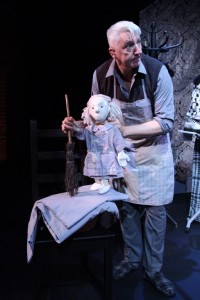By Kinny Gardner
 I have been creating theatrical work for Deaf children in the UK, but touring it in a Hearing world, for over 35 years and regularly come across vital misconceptions about D/deafness and its diaspora of cultural difference. As a ‘veteran’ creator, older than most yet younger than some, I thought to jot down these notes the purpose of which is to highlight ‘what is happening’ when you see a Deaf-inspired work, or indeed one of my shows.
I have been creating theatrical work for Deaf children in the UK, but touring it in a Hearing world, for over 35 years and regularly come across vital misconceptions about D/deafness and its diaspora of cultural difference. As a ‘veteran’ creator, older than most yet younger than some, I thought to jot down these notes the purpose of which is to highlight ‘what is happening’ when you see a Deaf-inspired work, or indeed one of my shows.
The Krazy Kat Theatre Company, for whom am Artistic Director, creates theatre incorporating Sign Language Arts which is accessible for deaf and disabled children and young people and is performed and taught by an integrated company of deaf and deaf-aware practitioners. Krazy Kat is hard of hearing led and deaf directed. The successful working combination of hard of hearing Artistic Director Kinny Gardner and Deaf Theatre Director Caroline Parker MBE has led to a distinctive, ambitious and high quality style of integrated Sign Language Arts. This has attracted disabled artists to the company who seek to reflect the ‘lived experience’ of deaf and hard of hearing children and young people.
My work for ‘early years’ audiences with Krazy Kat Theatre Company is recognised by many professionals working in the UK Disability Arts and Education field as being successfully reflective of aspects of patterns of early years play and is designed to address the issues facing the late narcissistic period of personal development. The work is designed to be age appropriate, many layered, subtly crafted and rich in iconographies of early years.
It is characterised by an approach that is based upon the needs and the abilities of young deaf and disabled children. Krazy Kat Theatre Company has a proven track record of engaging coherently with additional needs including Severe Learning Difficulties, Autistic Spectrum Disorder and Profound Multiple Learning Difficulties. They regularly re-visit mainstream, mixed ability and deaf schools, and many schools with Hearing Impairment Units. My mission is to give voice to deaf potential, extending the impact of signed theatre and encouraging other artists to bring it centre stage into the life of the mainstream community. All our work is fully accessible for families who are unable to bring their severely disabled child to the local theatre or arts centre due to the understandable issues of noise and physical displacement that a child with severe disabilities often exhibits.
Some principle issues that we address are the on-going vital issues of deaf access, deaf awareness and aspiration to integration. We demonstrate, both to deaf people and the hearing society, that deaf and hearing children have unity through culture and language which crosses national and cultural boundaries. Standards in disability awareness are raised and a better understanding of different people and cultures are nurtured.
Here are four bullet points of cultural recognition that I am often asked to share.
The Visual Language:
80% of British Sign Language is based around Non Manual Features. The placement and shaping of hands is vital, of course, but the bulk of the communication is facilitated by face, body placement and ‘role shift’. Often, in the past, signing actors have been accused of making ‘too many funny faces’; alas this shows a simple and understandable misunderstanding, and much of my work is about building a greater awareness of D/deaf cultural and linguistic identity in the Hearing world . Contrary to popular belief, most sign languages bear little resemblance to the spoken language. In other words, in the majority of cases, the various sign languages used have not actually developed from spoken languages. Further, most sign languages were invented by the deaf and thus bear little real resemblance to spoken language in form, having a greatly different syntax. A further point to be aware of is that it is a three dimensional language, and in consequence in theatrical presentations written ‘surtitles’ are at best obscure, when not meaningless.
Eye Breaks:
It is acknowledged that Deaf children need a rest from receiving information by hand and face. So in my touring theatre work I am using and developing ‘Eye breaks’: moments of storytelling where the information is presented as dance, shadow-play, mime, storyboard pictures etc., and which serves to both move the story along and let the child rest. It’s a form of ‘dynamic teaching’, using theatrical effects rather than white boards or Power Point.
Tiredness affects Deaf children to a much greater level than hearing. It is greatly exhausting for children trying to fit in to the “neurotypical” or hearing world. Think about the energy involved in lip reading, sign receiving, and being attentive all day long. Processing and constructing meaning out of half-heard words and sentences, making guesses and figuring out context. It’s like doing jigsaws, Suduku and Scrabble all at the same time.
Repetition:
As soon as a deaf person ‘looks away’ from the actor, they have missed the line; there is only the visual reception to rely on, no aural. So in my theatre work, as in Deaf sign conversation, I use reiteration and repetition. This successfully reflects the hearing oral storytelling tradition of repeating phrases and rhythms. It is also vital that only one person ‘speaks’ at a time, to allow the child to focus on the signer and receive the information.
Cultural Values:
There are many critical differences between Deaf and hearing cultures. Under no circumstances should the visual characteristic of sign language be ignored. Prosodic (the rhythm, stress, and intonation of speech) elements in the telling of the story need the linguistic sensitivity of a first-language translator, otherwise they will be lost. What cultural reference frames are applied when judging the work and value of Deaf led theatre? If we value diversity and the dignity of our young Deaf audiences, let us take a step back from rigid, phonocentristic reference frames and embrace Deaf culture in the great gift of those storytelling techniques handed down to us by Deaf artists.
It is imperative to keep in mind how much time and effort it may take for Deaf Children to fully comprehend questions posed from a hearing perspective, with the additional pressure of formulating relevant answers. This can interfere with the natural flow of communication and may destroy the psychological climate of the theatre experience to such an extent that no real significant exchange is possible. If there is inattention, distraction, indifference or inconsiderateness from a hearing theatre practitioner, no interpreter, regardless of qualification, can compensate for the insensitivity. Deaf theatre practitioners can communicate directly and easily with their audiences because they use sign language and share a common cultural background. (1110)



